Understanding Coaster Brook Trout Behavior in Lake Superior Informs Stocking Strategies
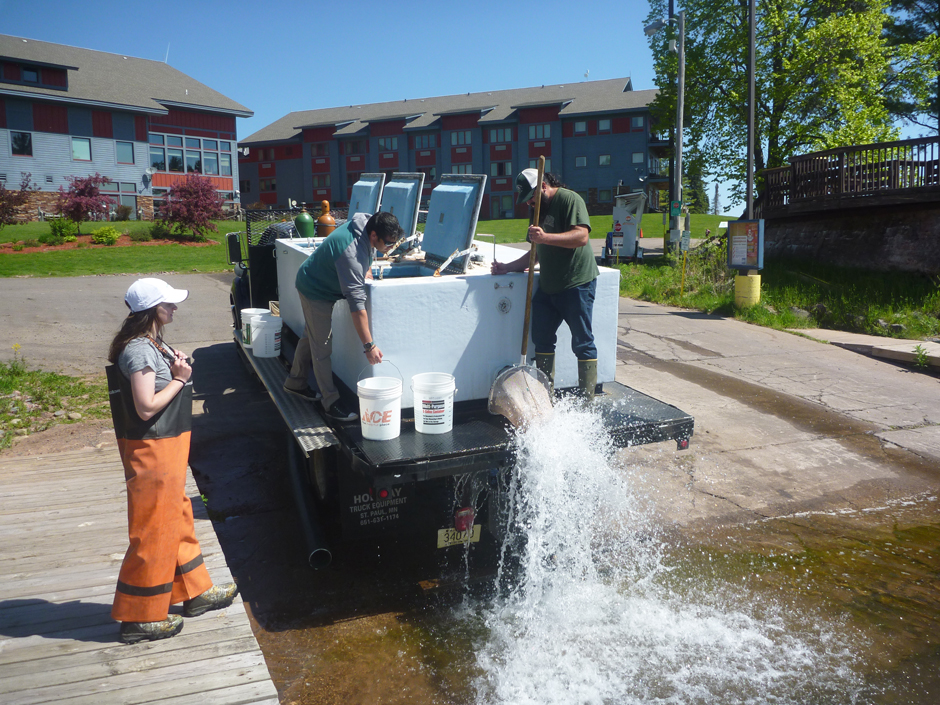 Stocking Coasters at Legendary Waters Casino (Red Cliff) spring 2021. Hatchery staff stocked most of the fish from the boat, but there’s usually a few left that get stocked at the boat ramp. (Ian Harding/Red Cliff Band of Lake Superior Chippewa Treaty Natural Resources Division).
Stocking Coasters at Legendary Waters Casino (Red Cliff) spring 2021. Hatchery staff stocked most of the fish from the boat, but there’s usually a few left that get stocked at the boat ramp. (Ian Harding/Red Cliff Band of Lake Superior Chippewa Treaty Natural Resources Division).Coaster brook trout, referred to here as coasters, are a valuable resource in Lake Superior, particularly after the species experienced significant declines in the late 1800s due to overfishing and habitat degradation. Now, populations in the Bayfield Peninsula have limited natural reproduction and are supported by the stocking efforts of groups like the Red Cliff Band of Lake Superior Chippewa. The Tribal Fish Hatchery has invested a great deal of time and money into restoring the once-thriving fishery.
Annual stocking efforts can have a significant impact on population sizes—but fish stocking has the potential to have a greater impact, depending on the strategies used. In order to test various stocking strategies and better understand Coasters’ behavior, the Tribal Fish Hatchery has spent the past decade studying various techniques and Coaster populations to develop a more comprehensive management strategy.
2016 Acoustic Telemetry: Pilot Study
The pilot study took place in 2016 and helped guide future research. Only 100 Coasters were stocked and tagged with VEMCO V5 180-kHZ acoustic tags. The tags were chosen due to size recommendations for the tags, though the size and frequency would limit the results of the study.
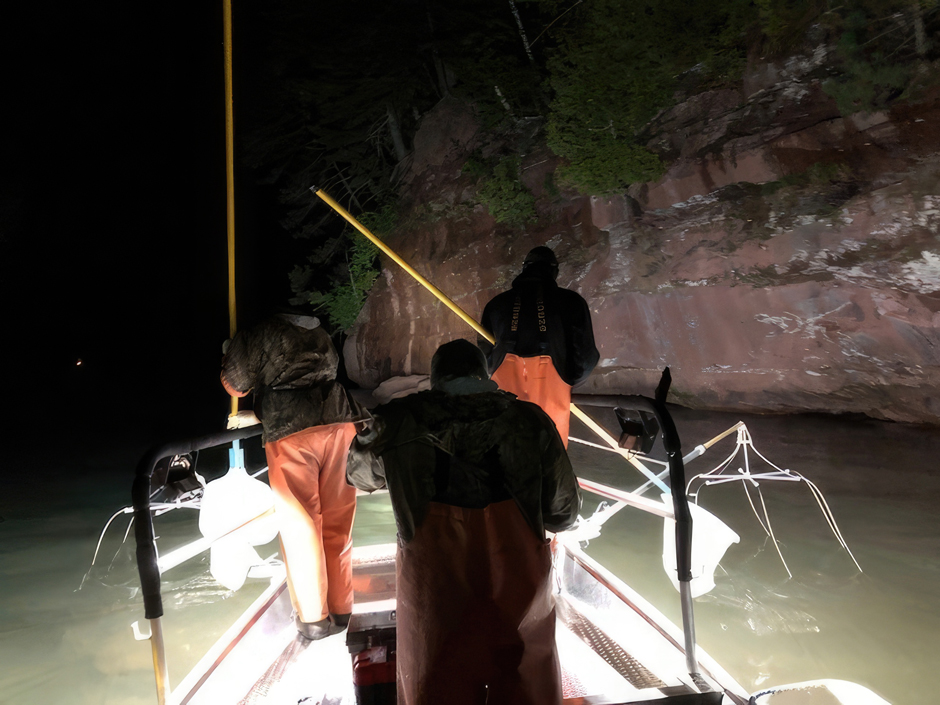
Red Cliff spring shoreline electrofishing survey–similar to many others that have been done since 2014 along the Bayfield Peninsula. The purpose is to index Coaster abundance and survey Coaster population demographics (wild or stocked, size/age composition). (Ian Harding/Red Cliff Band of Lake Superior Chippewa Treaty Natural Resources Division)
The Great Lakes Acoustic Telemetry Observation System (GLATOS) is a larger network of acoustic receivers through the Great Lakes. Essentially, the system supports local acoustic monitoring networks by pinging fish that travel outside of the bounds of the study area. Unfortunately, the frequency of the V5 tags was incompatible with these exterior receivers. Only three to five fish were stocked at each station, located at Frog Bay, Can Buoy, Schooner Bay and Roy’s Point.
Due to the limited number of tagged fish stocked as well as the limited access to receivers, the pilot study revealed several points to improve on and demonstrated a general behavior of the stocked fish moving south toward Roy’s Point. However, the results of the study were quite limited, so the group used the results of the pilot research to develop a more well-rounded study.
2019 Acoustic Telemetry: Final Study
Learning from the 2016 study, Ian Harding, a fisheries biologist with the Red Cliff Tribal Hatchery, explains that the team was determined to gather more information and have a greater volume of data to support any conclusions.
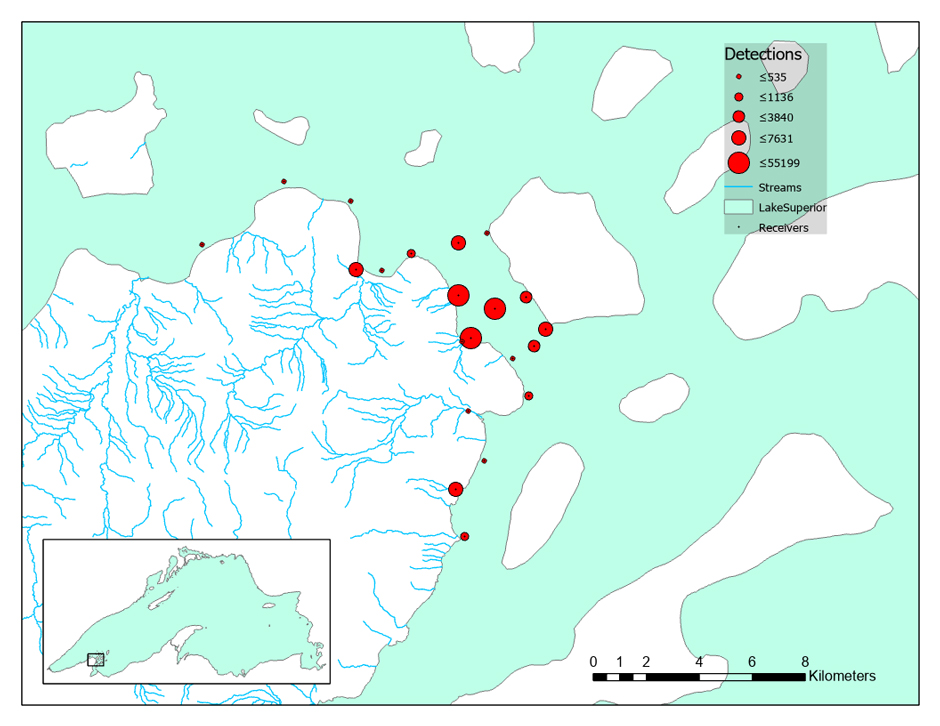
The number of detections of tagged Coasters at each receiver during the 2019 final study. (Credit: Ian Harding/Red Cliff Band of Lake Superior Chippewa Treaty Natural Resources Division).
The first step was to change to a lower frequency tag compatible with the GLATOS network. The new batch of Coasters were tagged with VEMCO V&D 69-kHZ tags and then scatter-stocked both nearshore and offshore. Twenty receivers were placed in the study area in order to better capture the movement of fish throughout the basin.
They also placed receivers in the mouth of tributaries, having learned that the fish seemed to gravitate toward Roy’s Point. 25 fish were stocked nearshore, and 25 were stocked offshore and then monitored for 150 days, per the battery life of the tags used. There were also concerns that the study would accidentally observe predator behavior, so the team invested in predation tags.
The tags send a unique signal when the fish has been eaten and can be used to inform stocking decisions as the time invested into rearing and stocking the fish becomes obsolete if they get eaten right away. Harding explains, “It does warrant the use of a predation tag to make sure you’re tracking brook trout behavior, not predator behavior.”
And the investment seemed to be well worth it as almost half the fish not predated disappeared after day 60 of the study. While there are several theories as to what happened, Harding states that there isn’t any solid evidence that proves any one theory.
However, Harding hypothesizes that the Coasters settled into a complex habitat that obstructed the acoustic signal (line-of-site) from reaching the receivers. He further elaborates, “So they initially moved around a lot, making themselves vulnerable to predation, then the ones that didn’t get eaten found suitable habitat and became more sedentary.”
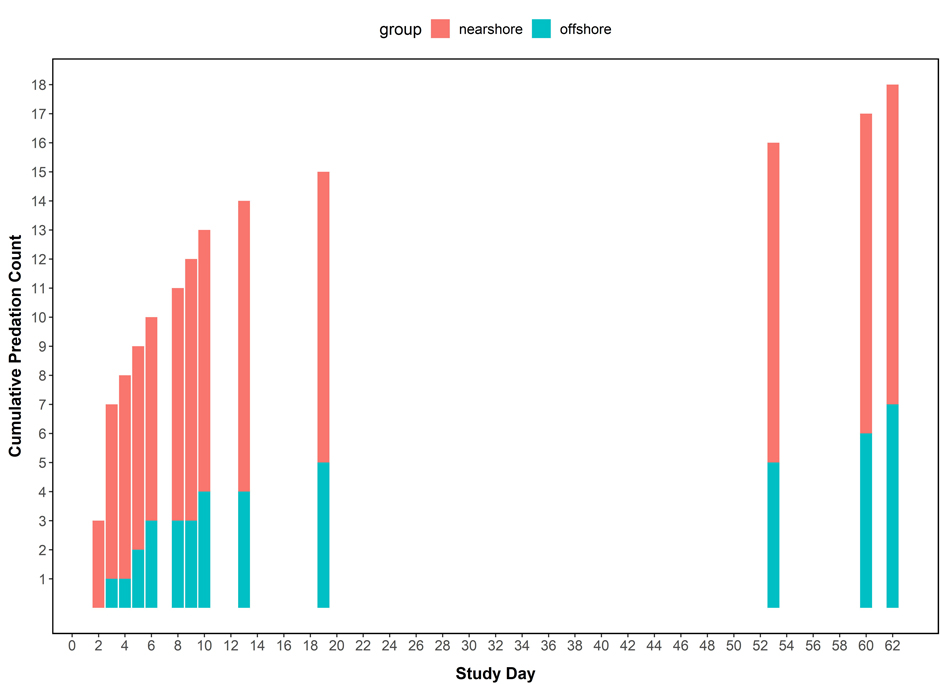
The cumulative predation count of tagged Coasters by study day by release group. Study day 1 = 6/12/2019. (Credit: (Ian Harding/Red Cliff Band of Lake Superior Chippewa Treaty Natural Resources Division)
The study concluded in June 2019 and revealed several new and previously unexpected behaviors. The receivers picked up fish not only traveling outside of the main bay between Frog Bay and Oak Island but also moving across the bay, showing that the coasters weren’t concerned about crossing several miles of deep water habitat, a new observation considering previous observations suggested the species preferred nearshore. Results of the study show that while the Coasters prefer nearshore habitat, much like previous studies had claimed, they will also cross deeper waters.
The research also revealed that many of the fish made their way up tributaries, something also previously thought to be uncommon behavior because electrofishing surveys in the rivers hadn’t caught Coasters in the past. The most popular tributary was Chicago Creek, and the least traversed was Red Cliff Creek—which is connected to the very hatchery waters the stocked fish were reared in.
This finding was particularly impactful because it shows that the Coasters aren’t returning to their hatchery waters. Previous research suggests that hatchery-reared fish imprint on their spawning waters, and will often attempt to return.
However, Coasters from the Red Cliff Fish Hatchery aren’t returning to the creek. Possibly indicating that the creek isn’t similar enough to the hatchery waters to attract the Coasters, or poor water quality is deterring the fish from returning. The hatchery is planning to conduct real-time water quality monitoring on the creek to better understand what is driving the Coasters away.
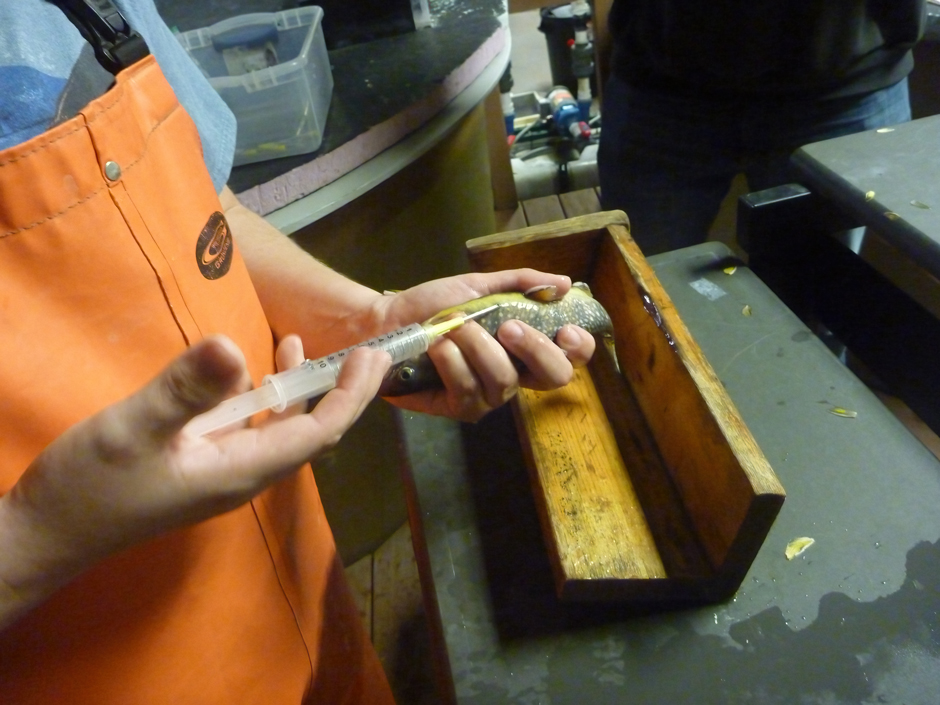
Red Cliff hatchery staff inserting a PIT tag into a Red Cliff hatchery Coaster. (Ian Harding/Red Cliff Band of Lake Superior Chippewa Treaty Natural Resources Division).
Future Research: Studying Coasters in Tributaries
With the results of the pilot and final study in mind, the fishery scientists shifted focus to the tributaries in 2021 in order to better inform stream restoration efforts. While the results of the acoustic telemetry studies revealed important information, the tags are costly. To save money and, therefore, increase the number of fish being studied, both wild and hatchery-reared Coasters were tagged with Passive Integrated Transponders, more commonly referred to as PIT tags.
PIT tag stations were constructed in Chicago Creek, Frog Creek, McCool Creek, Raspberry River and Red Cliff Creek. Each station registered the movement of tagged Coasters that moved through one of the stations and helped gather data on which streams were most popular. The lack of visits to Red Cliff Creek led the department to investigate water quality in the stream, and are currently in the process of developing a real-time monitoring strategy.
Chicago Creek was the most popular, and Harding believes this is a result of better water quality in Chicago Creek compared to the other waterways. While observations are ongoing, current results support efforts to restore the stream, which will begin with culvert restoration and monitoring how these culverts influence the movement of wild and hatchery-raised Coasters.
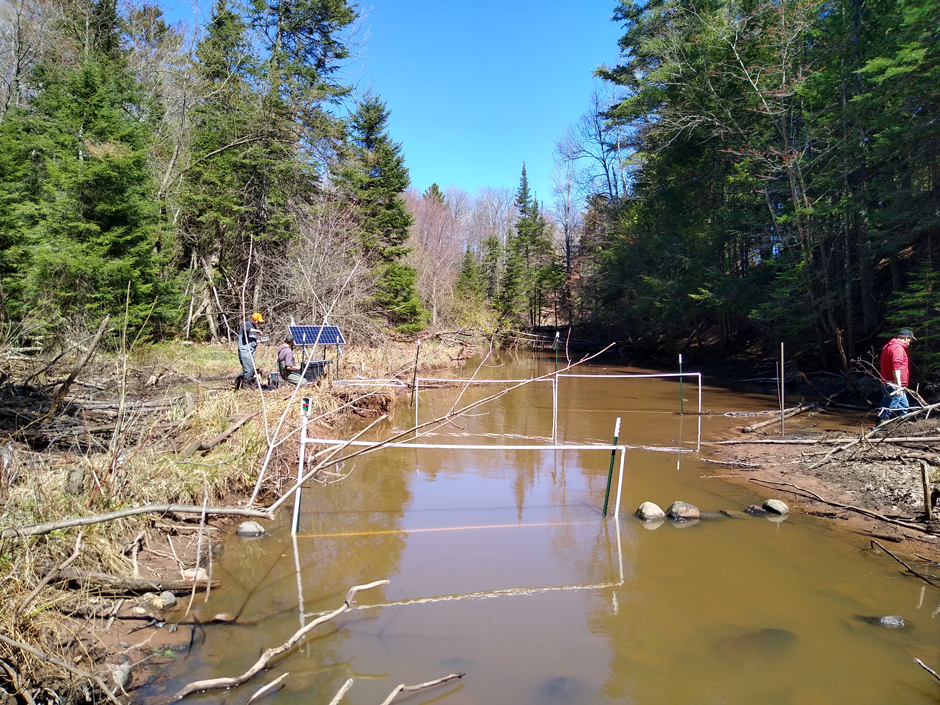
PIT tag station at Chicago Creek. Picture is taken facing downstream towards Lake Superior. The antennae are a pass-through design which maximizes tag detection. (Credit: Ian Harding/Red Cliff Band of Lake Superior Chippewa Treaty Natural Resources Division).


Pingback: FishSens Magazine | Acoustic Tagging Effort May Reveal How Coaster Brook Trout Use Lake Superior - FishSens Magazine
Pingback: FishSens Magazine | How Fishing Tournaments Impact Fisheries - FishSens Magazine
Pingback: Understanding Coaster Brook Trout Behavior in Lake Superior Informs Stocking Strategies – J.A.Henry Rod & Reel Co.
David Turnbull
January 25, 2025 at 9:56 am
Good work!
David Turnbull
January 25, 2025 at 9:57 am
Good work!